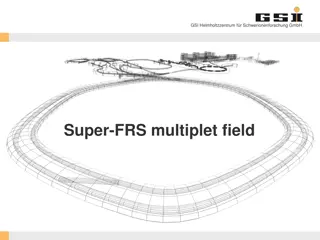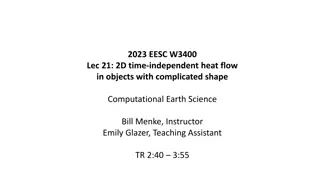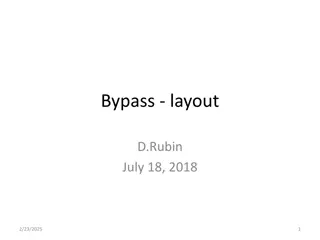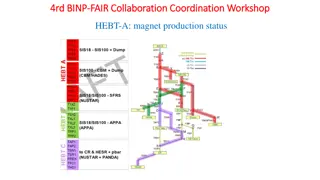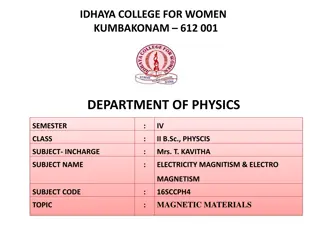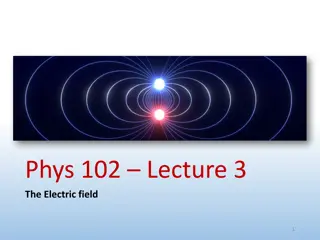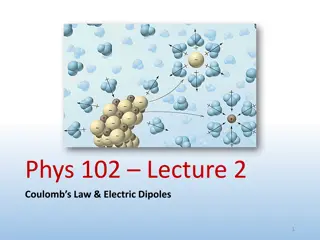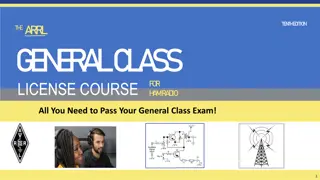INTERMOLECULAR FORCES (IMF)
Exploring the concepts of intramolecular bonds versus intermolecular forces, the impact of intermolecular forces on states of matter, different types of intermolecular forces, and the significance of dipoles in chemistry. Dive into the world of IMF with visual aids and real-world analogies.
2 views • 12 slides
Van der Waals Forces and Intermolecular Interactions
Van der Waals forces encompass London dispersion forces, dipole-dipole forces, and hydrogen bonding, influencing interactions between atoms and molecules. London dispersion forces are the weakest and present in all molecules, dipole-dipole forces involve permanent dipoles, and hydrogen bonding, the
0 views • 9 slides
Electric Dipole Interaction in Materials Physics
Dive into the world of electric dipole interaction in materials physics, exploring topics such as electromagnetic wave properties, force acting on electric dipoles, potential energy calculations, and the representation of waves through phasors. Learn about the differences between electromagnetic wav
1 views • 22 slides
Molecular Polarity and Electronegativity in Chemistry
Explore the concept of molecular polarity, electronegativity, and bonding in chemistry through engaging visuals and discussions. Learn how the unequal sharing of electrons between atoms leads to polarity in molecules and discover the role of electronegativity in attracting shared electrons. Delve in
0 views • 12 slides
Larmor's Theorem and Lagrangian Formulation in Electromagnetic Fields
Explore Larmor's Theorem, time-averaged forces, torques, and Lagrangian formulations for systems of charges in electromagnetic fields. Dive into the comparison with electric dipoles, transformation to rotating frames, and Lagrangian analysis for closed systems with finite motions. Uncover the intric
2 views • 13 slides
Magnetic Measurements and Dipoles: Preparation Meeting Overview
In the preparation meeting for Magnetic Measurements at CERN, GSI, and CEA, various aspects of dipoles and measurement systems were discussed. Topics included instrument configuration, cycling requirements, accuracy considerations, and practical aspects such as reproducibility. The meeting outlined
0 views • 18 slides
Overview of Magnet Configurations at GSI Helmholtzzentrum GmbH
This document provides detailed information on the magnet configurations at GSI Helmholtzzentrum GmbH, focusing on multiplet designs, magnetic field simulations, quadrupoles, sextupoles, and steering dipoles. It covers the general design of SC multiplets, requirements on axis and angles, and specifi
2 views • 17 slides
Proton Beam Switchyard (BSY) Status Summary - Horizon 2020 Programme
A detailed overview of the Proton Beam Switchyard (BSY) Status funded by the Horizon 2020 programme of the European Union. The aim of BSY is to ensure efficient distribution and focusing of the proton beam onto specific targets. The BSY composition includes various systems like deflecting, focusing,
0 views • 12 slides
Computational Earth Science: Solving Heat Flow in Objects with Complex Shapes Using Finite Difference Method
Explore projects involving the Finite Difference Method for solving static heat conduction problems, also known as the Poisson Equation. Topics include testing boundary conditions, symmetry of solutions, point sources, dipoles, and more. Gain insights into changing boundary conditions and understand
1 views • 20 slides
Magnetic Dipoles and Current Loops: Understanding Concepts
Magnetism is explored through magnetic dipoles and current loops in this lecture. Topics covered include magnetic dipole moments, alignment in fields, potential energy configurations, magnetotactic bacteria, NMR/MRI principles, and more. The interaction of magnetic fields with dipoles and currents i
0 views • 21 slides
Bypass Layout and Undulator Dimensions for Accelerator Science
This document contains detailed specifications and drawings for a bypass layout designed by D. Rubin on July 18, 2018. It includes components such as magnets, apertures, dipoles, and undulators for an accelerator-based science project. The revision history, zone descriptions, and equipment dimension
1 views • 7 slides
Key Topics in Diagnostics for High-field Magnets
Addressing performance limits and training mechanisms in high-field Nb3Sn dipoles, HTS degradation, and quench origins. Technical objectives include resolving magnet disturbances, improving voltage-based diagnostics, and developing fiber-optic instrumentation. Latest progress involves testing new ac
0 views • 6 slides
Electric Fields in Matter
This content delves into the fascinating world of electric fields in matter, exploring concepts such as polarization, the field of a polarized object, the electric displacement, and linear dielectrics. Discover how charges behave in conductors and insulators, and how dielectric atoms or molecules ar
0 views • 51 slides
FAIR Collaboration Coordination Workshop Status Update
This content provides an update on the status of the FAIR Collaboration Coordination Workshop, focusing on the production status of magnets including dipoles and quadrupoles. It details the preparation for shipment and ongoing production activities related to the steering magnets. The information is
0 views • 6 slides
Understanding Magnetic Field Lines and Flux
Magnetic field lines provide a visual representation of the direction of the magnetic field, similar to electric field lines. They help visualize the magnetic field's strength and direction. Cutting a permanent magnet in half results in two dipoles. Magnetic flux, a scalar quantity, is defined over
0 views • 11 slides
Understanding Magnetism and Magnetic Materials in Physics
Explore the world of magnetism and magnetic materials in physics, covering topics such as magnetic dipoles, types of magnetism like dia-magnetism, para-magnetism, ferro-magnetism, and their sub-classes anti-ferro-magnetism and ferri-magnetism. Learn why not all materials are magnets and compare dia,
0 views • 11 slides
Understanding Magnetism and Ferrofluid Demonstrations
Explore the fascinating world of magnets, magnetic fields, and ferrofluid with demonstrations and explanations. Learn about dipoles, pairs of dipoles, and the principle of minimum energy in this informative content. Discover how magnetic fields behave, attract, and cancel out in various configuratio
0 views • 18 slides
Understanding Electric Fields and Superposition Principle in Physics 102 Lecture 3
Learn about the electric field, superposition principle, and how to represent electric fields using field lines. Explore concepts like dipoles, conductors, and calculations for electric fields. Dive into scenarios involving point charges, lines of charges, and planes of charges. Test your understand
0 views • 22 slides
Understanding Coulomb's Law and Electric Dipoles in Physics 102 Lecture
Explore the fundamentals of Coulomb's Law and electric dipoles in Physics 102 Lecture. Learn about molecular interactions, polar vs. nonpolar molecules, hydrophilic vs hydrophobic properties, and more. Practice using Coulomb's Law, vector addition, and apply these concepts to understand the behavior
0 views • 23 slides
Pass Your General Class Exam with TE.N.TH.E.D.ITION Course
Prepare for your General Class exam with the comprehensive TE.N.TH.E.D.ITION course, covering essential topics such as antennas, dipoles, and ground-planes. Gain valuable insights and resources to help you succeed in obtaining your General Class license for HAM radio. Get ready to ace your exam with
0 views • 66 slides






